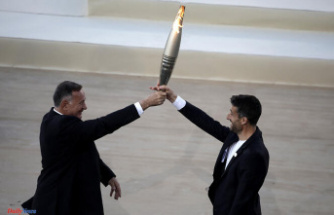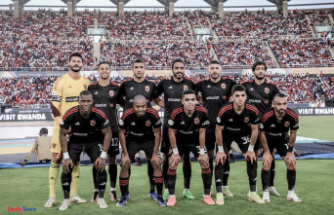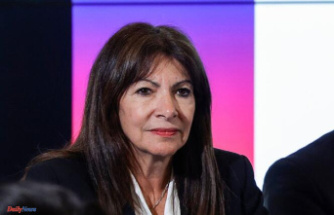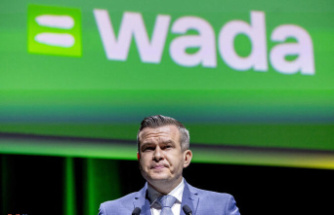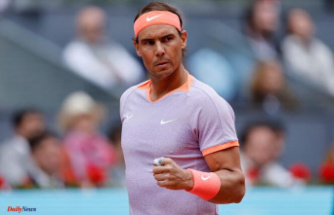Black skiers are fighting for their Olympic dreams on the slopes
BEIJING (AP), -- An informal survey of American Alpine skiers and snowboarders reveals that most people can name an organization that promotes winter sports to Black and Hispanic children living in urban areas.
There are many programs that aim to develop a diverse group of snowboarders and skiers, whether it's indoor halfpipes in New Jersey or Rocky Mountain slopes in Colorado and Wyoming.
Where are the Black and Hispanic American Winter Olympics athletes?
The U.S. Alpine Ski Team in Beijing is completely white. Freestyle and snowboarders from the United States include American Asian riders, but no Hispanic or Black.
Ryan Cochran Siegle, an American super-G Beijing silver medalist, said that "it's incredibly unfortunate." "We all want ways to bridge the gap between minorities and allow them to ski.
Black skiers are fighting for their Olympic dreams on the slopes
By AARON MORRISON
Today
Richardson Viano of Haiti celebrates finishing the men's ski slalom race 2 at the 2022 Winter Olympics. This was Wednesday, February 16, 2022 in the Yanqing District of Beijing. Haiti sent Richardson Viano, a skier, to China as the first ever winter Olympian. Viano learned to ski in France, after being adopted by a French family. Most of the African and Caribbean athletes in the Games were either born or raised in countries that have ski slopes or training facilities. (AP Photo/Pavel Golovkin)
1 out of 6
Richardson Viano of Haiti celebrates finishing the men's ski slalom race 2 at the 2022 Winter Olympics. This was Wednesday, February 16, 2022 in the Yanqing District of Beijing. Haiti sent Richardson Viano, a skier, to China as the first ever winter Olympian. Viano learned to ski in France, after being adopted by a French family. Most of the African and Caribbean athletes in the Games were either born or raised in countries that have ski slopes and training facilities. (AP Photo/Pavel Golovkin)
BEIJING (AP), -- An informal survey of American Alpine skiers and snowboarders reveals that most people can name an organization that promotes winter sports to Black and Hispanic children living in urban areas.
There are many programs that aim to develop a diverse group of snowboarders and skiers, whether it's indoor halfpipes in New Jersey or Rocky Mountain slopes in Colorado and Wyoming.
Where are the Black and Hispanic American Winter Olympics athletes?
The U.S. Alpine Ski Team in Beijing is completely white. Freestyle and snowboarders from the United States include American Asian riders, but no Hispanic or Black.
Ryan Cochran Siegle, an American super-G Beijing silver medalist, said that "it's incredibly unfortunate." "We all want ways to bridge the gap between minorities and allow them to ski.
ADVERTISEMENT
Both the past and present of alpine sports work against this goal. They are white and elitist and were born in Europe's mountains. They thrive in mountain communities with little racial and ethnic diversity.
There is also the issue of cost. A day of skiing can run to $100, including travel and equipment rentals. Owning your own equipment costs more. Access to resorts and wealth can make a big difference in your ability to move from recreational-level to Olympic level participation. Owning your own equipment is even more expensive. Bode Miller's six Olympic Alpine medals, which are the most awarded to any American skier, was a testament to this fact.
Miller stated, "If your family doesn't ski or you were not exposed to it during your childhood, it's very unusual." "Your friends must push you to do it."
Miller and others believe that the solution to the lackluster diversity in snowboarding and skiing is to provide access to the slopes to underserved communities.
Miller is part of a group that works to create indoor ski facilities in the United States.
Advocates claim that programs like the two-day-a week programs that make it possible for Hispanic and Black children to have a positive impact on the snow are making a difference. However, the Olympics is still far from being a success.
The chances of an athlete making the Olympic team are significantly increased by intensive training at elite boarding schools and academies, which can be expensive.
Schone Malliet is a Black CEO who founded Winter4Kids. This nonprofit makes winter sports more accessible to New York-area schoolkids. Malliet stated that this is the deal. They change their entire outlook on life. Don't think about cross-country skiing or snowboarding, but building the belief that "I can fall down, and get up."
Diversity in racial makeup is still a novelty in many winter sports, not only skiing and snowboarding.
Beijing has only one Black figure skating champion. American Erin Jackson, a Black woman in speedskating, won the gold medal on Sunday. Other events offer long shot opportunities for medals to Black and Hispanic competitors.
In fact, there are some people of color participating in the Beijing Olympics' ski events. They come from the African and Caribbean countries of Ghana, Nigeria Eritrea, Eritrea, Jamaica. Haiti sent Richardson Viano, a skier, to China as the first ever winter Olympian.
Jean-Pierre Roy was present to see Viano in the giant Slalom. He said that Haitians have taken an interest in the sport because of Viano's pioneering participation.
He said, "There must be dreams." "Without dreams, there is no progress."
Viano learned to ski in France, after being adopted by a French family. Most of the African and Caribbean athletes in the Games were either born or raised in countries that have ski slopes and training facilities.
Sophie Goldschmidt is the head of U.S. Sophie Goldschmidt, head of U.S. Skiing, stated that inclusion is a core value of her organization, but acknowledged the obstacles to progress in skier diversity.
She said, "Whether it's cost prohibitive or exclusive for other reasons it's something I want to change."
An audit in 2021 of diversity, equity, and inclusion of U.S. The organization's skiers revealed that it is almost entirely white. Only 1% of the staff were identified as people from color, and all its coaches and board members are white.
Seba Johnson saw skiing for the first time on a small black-and-white TV she had in her Fredericksted apartment. It was on the island St Croix. It was amazing. She was 5 years old when she saw it in person and decided that she wanted to become a ski racer.
Johnson, nine years later, broke all barriers at the 1988 Calgary Games. She became the first Black woman to compete in a Winter Games and, at 14 years old, the youngest. Johnson relied on the support of ski equipment companies, celebrities, and other donors to train, but she was still able to train far less than her competitors.
Johnson, 48, stated in an interview that "no one should have to beg" for the opportunity to do what they desire.
She competed at the Olympics again, representing the U.S Virgin Islands, but there was not another Black woman competing in an Olympic Alpine skiing event until 30 years later when Sabrina Simader from Kenya participated in the 2018 Games in Pyeongchang.
She described it as "heartbreaking" to see that Black representation in skiing isn't improving.
Andre Horton, a native Alaskan skier, became the first Black American to join the U.S. team in 2001. However, he has never competed at the Olympics.
Horton was introduced by another Black skier to the National Brotherhood of Skiers. This is a Black-led organization that advocates for more representation in winter sports. Horton was astonished to see so many other skiers with the same appearance at the Aspen convention. Horton said that other guests were amazed to see him wearing his national ski team uniform.
Horton recalled riding a chairlift that day with a 70 year-old Black woman. She was a strong example of how important Black representation in the sport is.
"She said that she was not allowed to ski when I was your age."
Henri Rivers, the president of the National Brotherhood of Skiers, stated that this is exactly why they exist. Its goal is to remove racial barriers and social barriers from Black athletes in order for them to excel in winter sports.
The pipeline's Black and Hispanic skiers aren’t ready to compete in the Olympic team. Rivers stated that they would do well if the wider ski community accepted them and considered them the future of the sport.
They don't realize the obstacles that are put in their path to slow down their progress.


